Fitzgerald A.E. Electric Machinery
Подождите немного. Документ загружается.


406 CHAPTER 7 DC Machines
a. Calculate the rated-load speed of this motor.
In order to protect both the motor and the dc supply under starting
conditions, an external resistance will be connected in series with the
armature winding (with the field winding remaining directly across the 230-V
supply). The resistance will then be automatically adjusted in steps so that
the armature current does not exceed 200 percent of rated current. The step
size will be determined such that, until all the extemal resistance is switched
out, the armature current will not be permitted to drop below rated value. In
other words, the machine is to start with 200 percent of rated armature
current and as soon as the current falls to rated value, sufficient series
resistance is to be cut out to restore the current to 200 percent. This process
will be repeated until all of the series resistance has been eliminated.
b. Find the maximum value of the series resistance.
c. How much resistance should be cut out at each step in the starting
operation and at what speed should each step change occur?
7.24 The manufacturer's data sheet for a permanent-magnet dc motor indicates
that it has a torque constant Km = 0.21 V/(rad/sec) and an armature resistance
of 1.9 f2. For a constant applied armature voltage of 85 V dc, calculate
a. the no-load speed of the motor in r/min and
b. its stall (zero-speed) current and torque (in N. m).
c. Plot the motor torque as a function of speed.
7.25 Measurements on a small permanent-magnet dc motor indicate that it has an
armature resistance of 4.6 f2. With an applied armature voltage of 5 V, the
motor is observed to achieve a no-load speed of 11,210 r/min while drawing
an armature current of 12.5 mA.
a. Calculate the motor torque constant Km in V/(rad/sec).
b. Calculate the no-load rotational losses in mW.
Assume the motor to be operating from an applied armature voltage of
5V.
c. Find the stall current and torque of the motor.
d. At what speeds will the motor achieve an output power of 1 W? Estimate
the motor efficiency under these operating conditions. Assume that the
rotational loss varies as the cube of the speed.
7.26 Write a MATLAB script to calculate the parameters of a dc motor. The inputs
will be the armature resistance and the no-load armature voltage, speed, and
armature current. The output should be the no-load rotational loss and the
torque constant Km.
7.27 The dc motor of Problem 7.25 will be used to drive a load which requires a
power of 0.75 W at a speed of 8750 r/min. Calculate the armature voltage
which must be applied to achieve this operating condition.
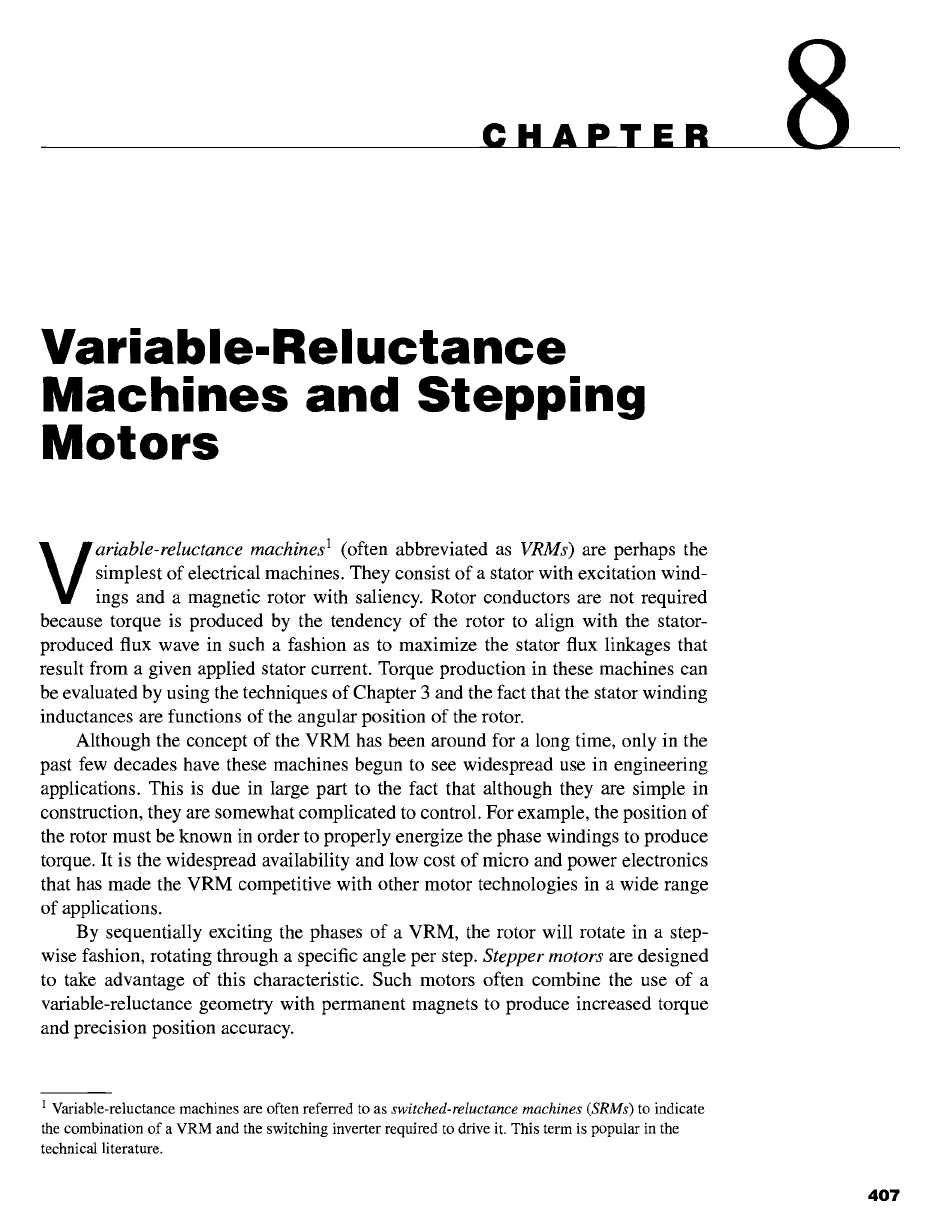
CHAPTER
Variable.Rel uctance
Machines and Stepping
Motors
V
ariable-reluctance machines 1
(often abbreviated as
VRMs)
are perhaps the
simplest of electrical machines. They consist of a stator with excitation wind-
ings and a magnetic rotor with saliency. Rotor conductors are not required
because torque is produced by the tendency of the rotor to align with the stator-
produced flux wave in such a fashion as to maximize the stator flux linkages that
result from a given applied stator current. Torque production in these machines can
be evaluated by using the techniques of Chapter 3 and the fact that the stator winding
inductances are functions of the angular position of the rotor.
Although the concept of the VRM has been around for a long time, only in the
past few decades have these machines begun to see widespread use in engineering
applications. This is due in large part to the fact that although they are simple in
construction, they are somewhat complicated to control. For example, the position of
the rotor must be known in order to properly energize the phase windings to produce
torque. It is the widespread availability and low cost of micro and power electronics
that has made the VRM competitive with other motor technologies in a wide range
of applications.
By sequentially exciting the phases of a VRM, the rotor will rotate in a step-
wise fashion, rotating through a specific angle per step.
Stepper motors are
designed
to take advantage of this characteristic. Such motors often combine the use of a
variable-reluctance geometry with permanent magnets to produce increased torque
and precision position accuracy.
1 Variable-reluctance machines are often referred to as
switched-reluctance machines (SRMs)
to indicate
the combination of a VRM and the switching inverter required to drive it. This term is popular in the
technical literature.
407
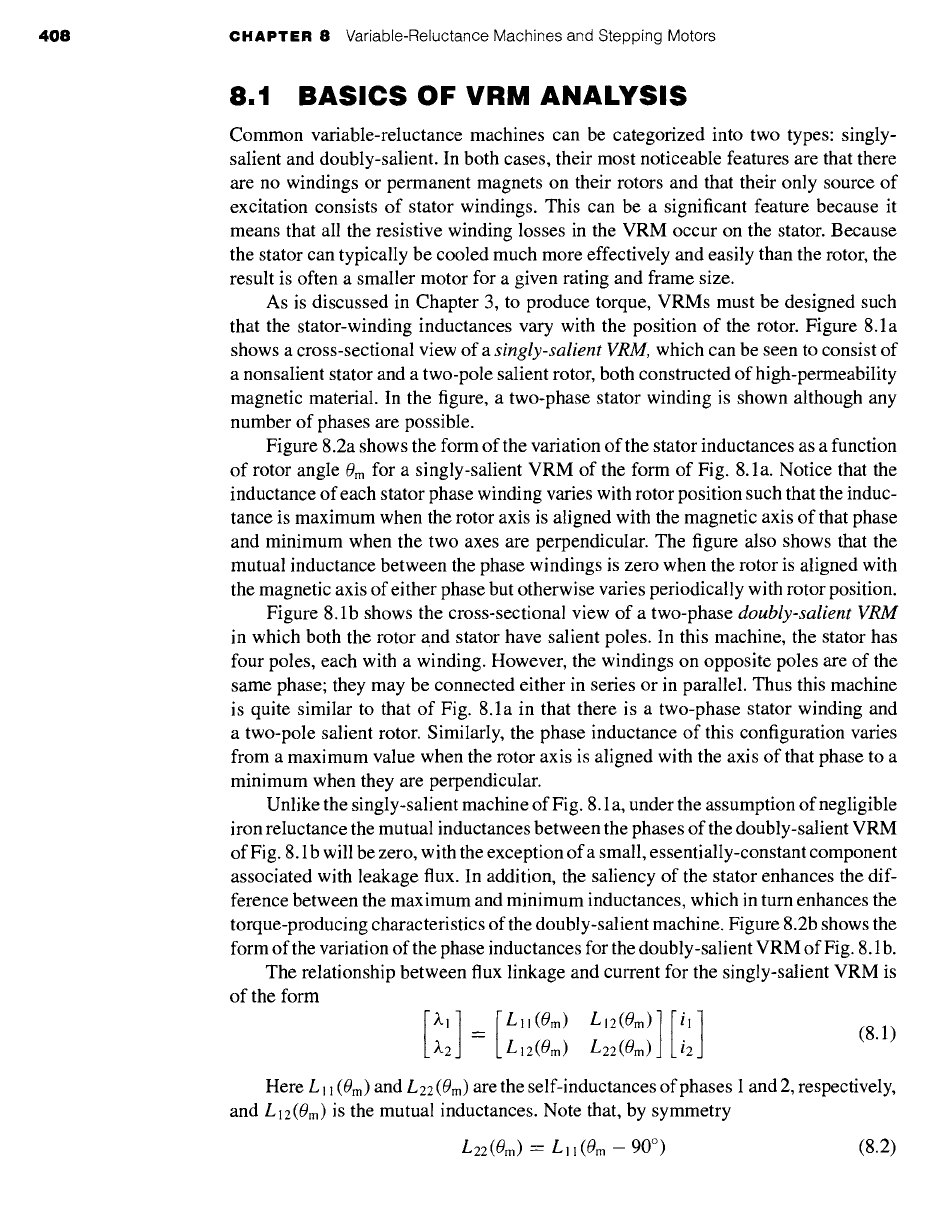
408 CHAPTER 8 Variable-Reluctance Machines and Stepping Motors
8.1 BASICS OF VRM ANALYSIS
Common variable-reluctance machines can be categorized into two types: singly-
salient and doubly-salient. In both cases, their most noticeable features are that there
are no windings or permanent magnets on their rotors and that their only source of
excitation consists of stator windings. This can be a significant feature because it
means that all the resistive winding losses in the VRM occur on the stator. Because
the stator can typically be cooled much more effectively and easily than the rotor, the
result is often a smaller motor for a given rating and frame size.
As is discussed in Chapter 3, to produce torque, VRMs must be designed such
that the stator-winding inductances vary with the position of the rotor. Figure 8.1a
shows a cross-sectional view of a
singly-salient VRM,
which can be seen to consist of
a nonsalient stator and a two-pole salient rotor, both constructed of high-permeability
magnetic material. In the figure, a two-phase stator winding is shown although any
number of phases are possible.
Figure 8.2a shows the form of the variation of the stator inductances as a function
of rotor angle 0m for a singly-salient VRM of the form of Fig. 8.1 a. Notice that the
inductance of each stator phase winding varies with rotor position such that the induc-
tance is maximum when the rotor axis is aligned with the magnetic axis of that phase
and minimum when the two axes are perpendicular. The figure also shows that the
mutual inductance between the phase windings is zero when the rotor is aligned with
the magnetic axis of either phase but otherwise varies periodically with rotor position.
Figure 8. lb shows the cross-sectional view of a two-phase
doubly-salient VRM
in which both the rotor and stator have salient poles. In this machine, the stator has
four poles, each with a winding. However, the windings on opposite poles are of the
same phase; they may be connected either in series or in parallel. Thus this machine
is quite similar to that of Fig. 8.1a in that there is a two-phase stator winding and
a two-pole salient rotor. Similarly, the phase inductance of this configuration varies
from a maximum value when the rotor axis is aligned with the axis of that phase to a
minimum when they are perpendicular.
Unlike the singly-salient machine of Fig. 8.1 a, under the assumption of negligible
iron reluctance the mutual inductances between the phases of the doubly-salient VRM
of Fig. 8.1 b will be zero, with the exception of a small, essentially-constant component
associated with leakage flux. In addition, the saliency of the stator enhances the dif-
ference between the maximum and minimum inductances, which in turn enhances the
torque-producing characteristics of the doubly-salient machine. Figure 8.2b shows the
form of the variation of the phase inductances for the doubly-salient VRM of Fig. 8. lb.
The relationship between flux linkage and current for the singly-salient VRM is
of the form
~.2 = Llz(0m) L22(0m) i2 (8.1)
Here L 11 (0m) and L 22 (0m) are the self-inductances of phases 1 and 2, respectively,
and L l2(0m) is the mutual inductances. Note that, by symmetry
L22(0m) ~- L II (0m -
90 °) (8.2)
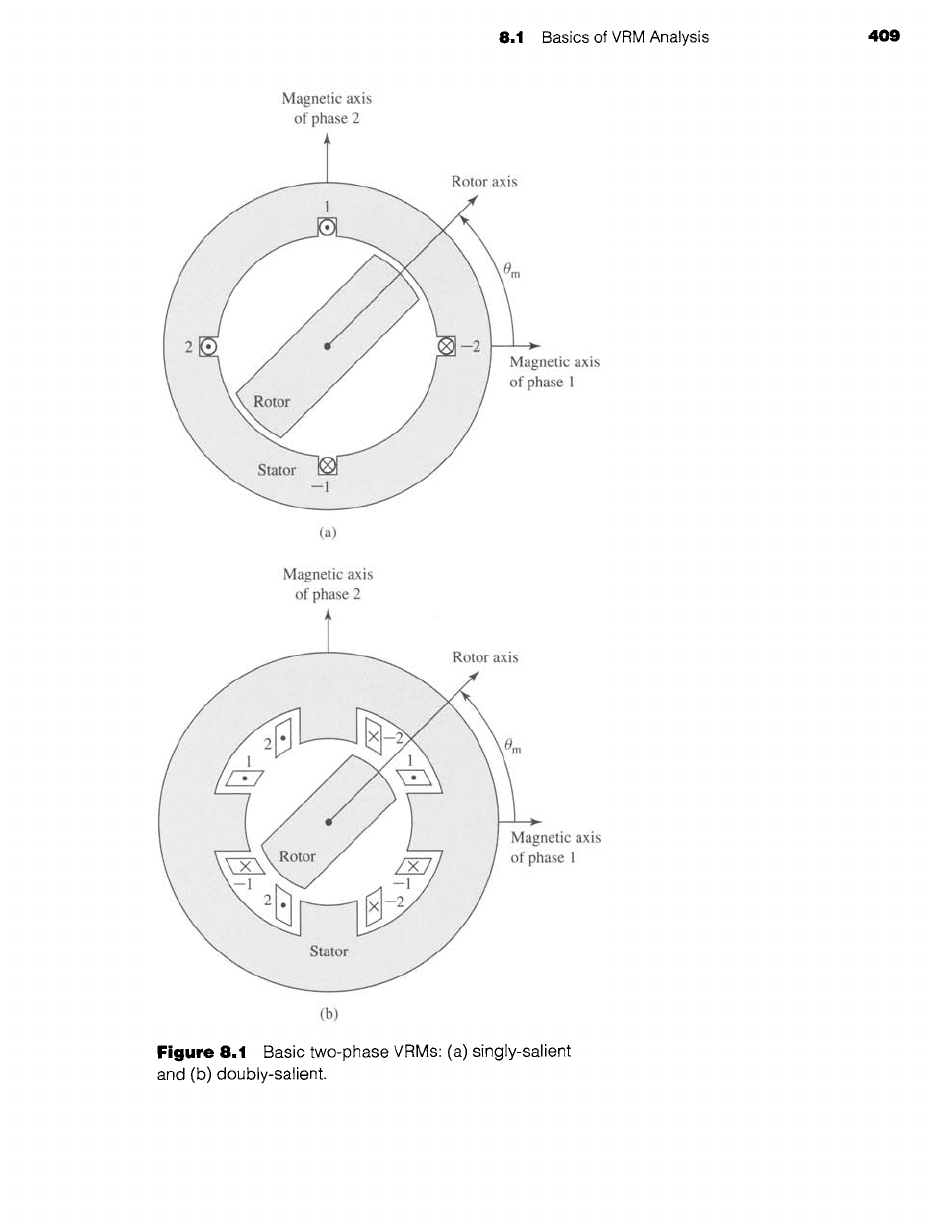
8.1 Basics of VRM Analysis 409
Magnetic axis
of phase 2
Rotor axis
0m
Magnetic axis
of phase 1
(a)
Magnetic axis
of phase 2
Rotor axis
/77
0m
Magnetic axis
of phase 1
(b)
Figure 8.1
Basic two-phase VRMs: (a) singly-salient
and (b) doubly-salient.

4t0 CHAPTER 8
Variable-Reluctance Machines and Stepping Motors
Lll(Om)
.¢ S~- -?--- ',,
/
_900\ 90°\ /180 o ~0m
-- 180 °
\ / \ /
L12(Om)
(a)
Lll (0 m) L22(0 m) |
% /",, /~ ,",, /-.
__
--180 ° --90 ° I 0 ° 90 ° 180 °
1
(b)
Figure 8.2
Plots of inductance versus
0m
for (a) the singly-salient
VRM of Fig. 8.1a and (b) the doubly-salient VRM of Fig. 8.1b.
Note also that all of these inductances are periodic with a period of 180 ° because
rotation of the rotor through 180 ° from any given angular position results in no
change in the magnetic circuit of the machine.
From Eq. 3.68 the electromagnetic torque of this system can be determined from
the coenergy as
O W~d(il, i2, 0m)
Tmech = (8.3)
00m
where the partial derivative is taken while holding currents
i l
and
i2
constant. Here,
the coenergy can be found from Eq. 3.70,
1 1
Wild -- -~Lll(Om)i 2 + Ll2(Om)ili2 +
-~L22(Om)i]
(8.4)
Thus, combining Eqs. 8.3 and 8.4 gives the torque as
1 dL
(Om)
dL
(Om) 1
dL22(Om)
Tmech -- ~i 2 11 12
l dOm +
il i2 -- a t- i 2
(8.5)
dOm -2 dOm
For the double-salient VRM of Fig. 8. lb, the mutual-inductance term dL 12 (0m)/d0m
is zero and the torque expression of Eq. 8.5 simplifies to
Tmech--~i~dLll(Om)+
~i] dL22(Om)
dOm dOm
(8.6)
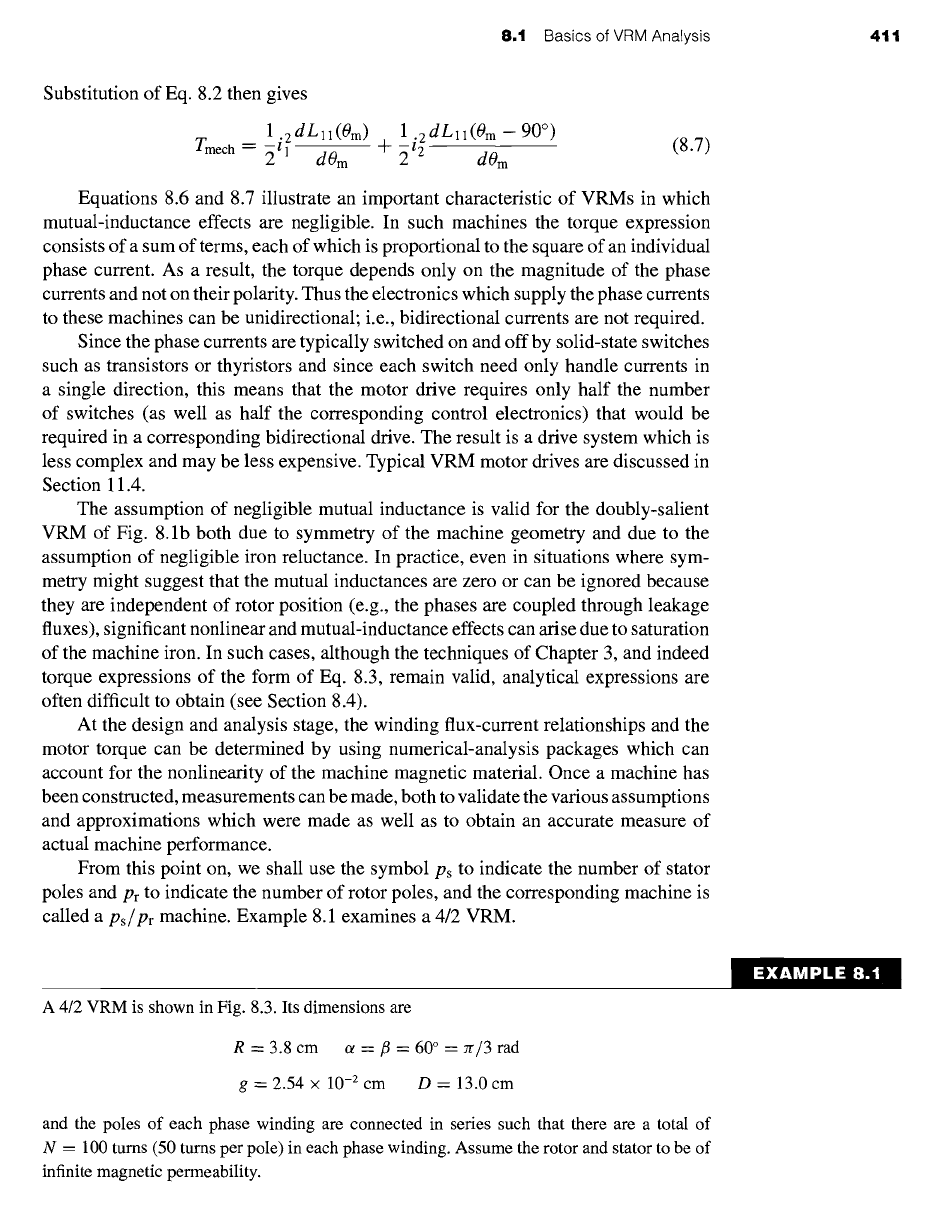
8.1 Basics of VRM Analysis 411
Substitution of Eq. 8.2 then gives
~i2dLll(Om) 1.2dLll(Om
--
90 °)
Tmech
dOm + -~l 2 dOm
(8.7)
Equations 8.6 and 8.7 illustrate an important characteristic of VRMs in which
mutual-inductance effects are negligible. In such machines the torque expression
consists of a sum of terms, each of which is proportional to the square of an individual
phase current. As a result, the torque depends only on the magnitude of the phase
currents and not on their polarity. Thus the electronics which supply the phase currents
to these machines can be unidirectional; i.e., bidirectional currents are not required.
Since the phase currents are typically switched on and offby solid-state switches
such as transistors or thyristors and since each switch need only handle currents in
a single direction, this means that the motor drive requires only half the number
of switches (as well as half the corresponding control electronics) that would be
required in a corresponding bidirectional drive. The result is a drive system which is
less complex and may be less expensive. Typical VRM motor drives are discussed in
Section 11.4.
The assumption of negligible mutual inductance is valid for the doubly-salient
VRM of Fig. 8.1b both due to symmetry of the machine geometry and due to the
assumption of negligible iron reluctance. In practice, even in situations where sym-
metry might suggest that the mutual inductances are zero or can be ignored because
they are independent of rotor position (e.g., the phases are coupled through leakage
fluxes), significant nonlinear and mutual-inductance effects can arise due to saturation
of the machine iron. In such cases, although the techniques of Chapter 3, and indeed
torque expressions of the form of Eq. 8.3, remain valid, analytical expressions are
often difficult to obtain (see Section 8.4).
At the design and analysis stage, the winding flux-current relationships and the
motor torque can be determined by using numerical-analysis packages which can
account for the nonlinearity of the machine magnetic material. Once a machine has
been constructed, measurements can be made, both to validate the various assumptions
and approximations which were made as well as to obtain an accurate measure of
actual machine performance.
From this point on, we shall use the symbol ps to indicate the number of stator
poles and Pr to indicate the number of rotor poles, and the corresponding machine is
called a
Ps/Pr
machine. Example 8.1 examines a 4/2 VRM.
A 4/2 VRM is shown in Fig. 8.3. Its dimensions are
R = 3.8 cm ot =/3 = 60 ° = rr/3 rad
g -- 2.54 × 10 -2 cm D = 13.0 cm
and the poles of each phase winding are connected in series such that there are a total of
N = 100 turns (50 turns per pole) in each phase winding. Assume the rotor and stator to be of
infinite magnetic permeability.
EXAMPLE 8 1
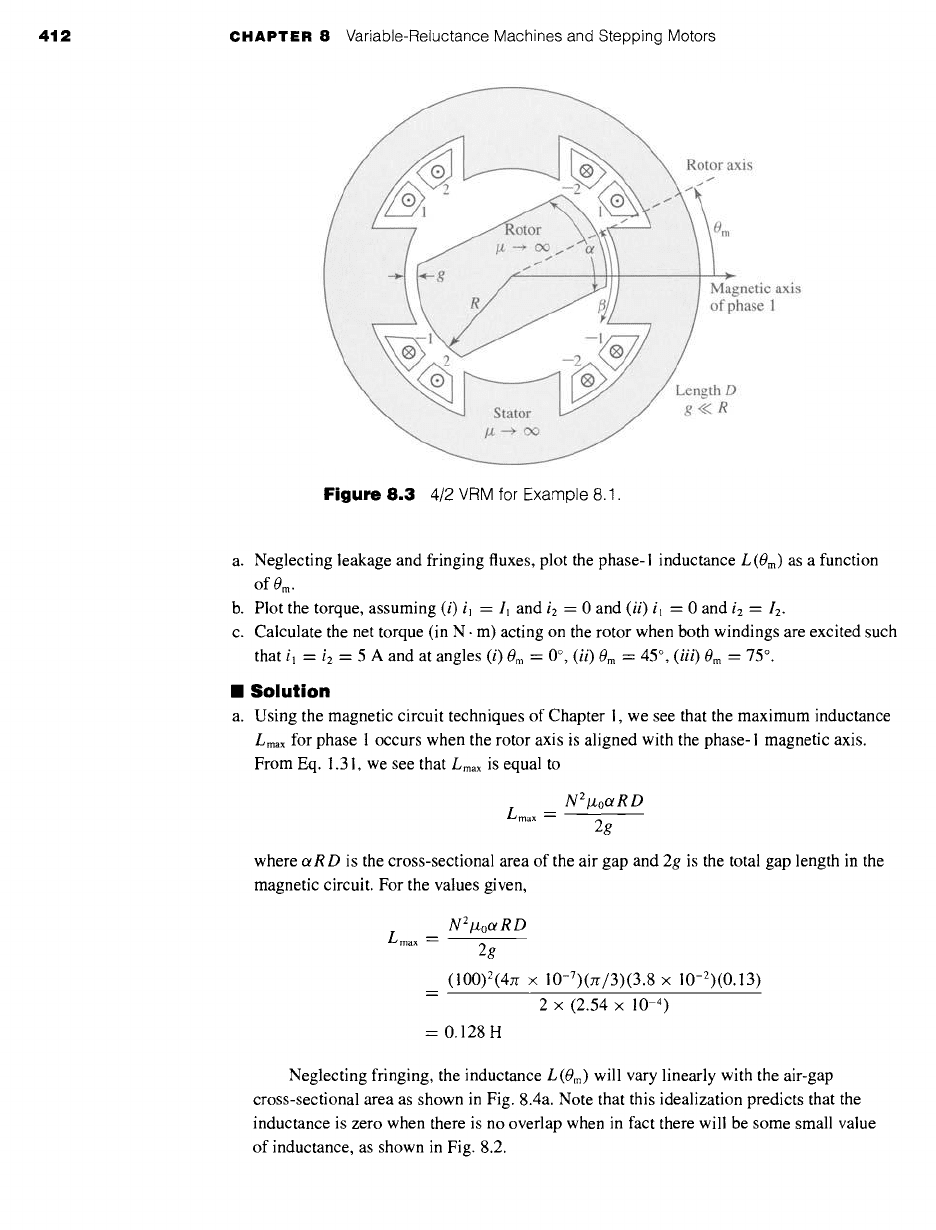
412 CHAPTER 8 Variable-Reluctance Machines and Stepping Motors
--2
Rotor axis
I
0m
Magnetic axis
of phase 1
Length D
g<< R
Figure 8.3
4/2 VRM for Example 8.1.
a. Neglecting leakage and fringing fluxes, plot the phase-1 inductance
L(0m) as
a function
of 0m.
b. Plot the torque, assuming (i) il = 11 and i2 = 0 and
(ii)
i~ = 0 and
iz = 12.
c. Calculate the net torque (in N. m) acting on the rotor when both windings are excited such
that il = i2 = 5 A and at angles (i) 0m = 0 °,
(ii)
0m = 45 °,
(iii)
0m = 75 °.
II
Solution
a. Using the magnetic circuit techniques of Chapter 1, we see that the maximum inductance
Lmax
for phase 1 occurs when the rotor axis is aligned with the phase-1 magnetic axis.
From Eq. 1.31, we see that
Lmax is
equal to
N 2 #oU R D
L max =
2g
where ct R D is the cross-sectional area of the air gap and 2g is the total gap length in the
magnetic circuit. For the values given,
N 2 #oot R D
L max -~-
2g
(100)2(47[ × 10-7)(~/3)(3.8 × 10-2)(0.13)
2 × (2.54 × 10 -4)
= 0.128H
Neglecting fringing, the inductance
L(Om)
will vary linearly with the air-gap
cross-sectional area as shown in Fig. 8.4a. Note that this idealization predicts that the
inductance is zero when there is no overlap when in fact there will be some small value
of inductance, as shown in Fig. 8.2.
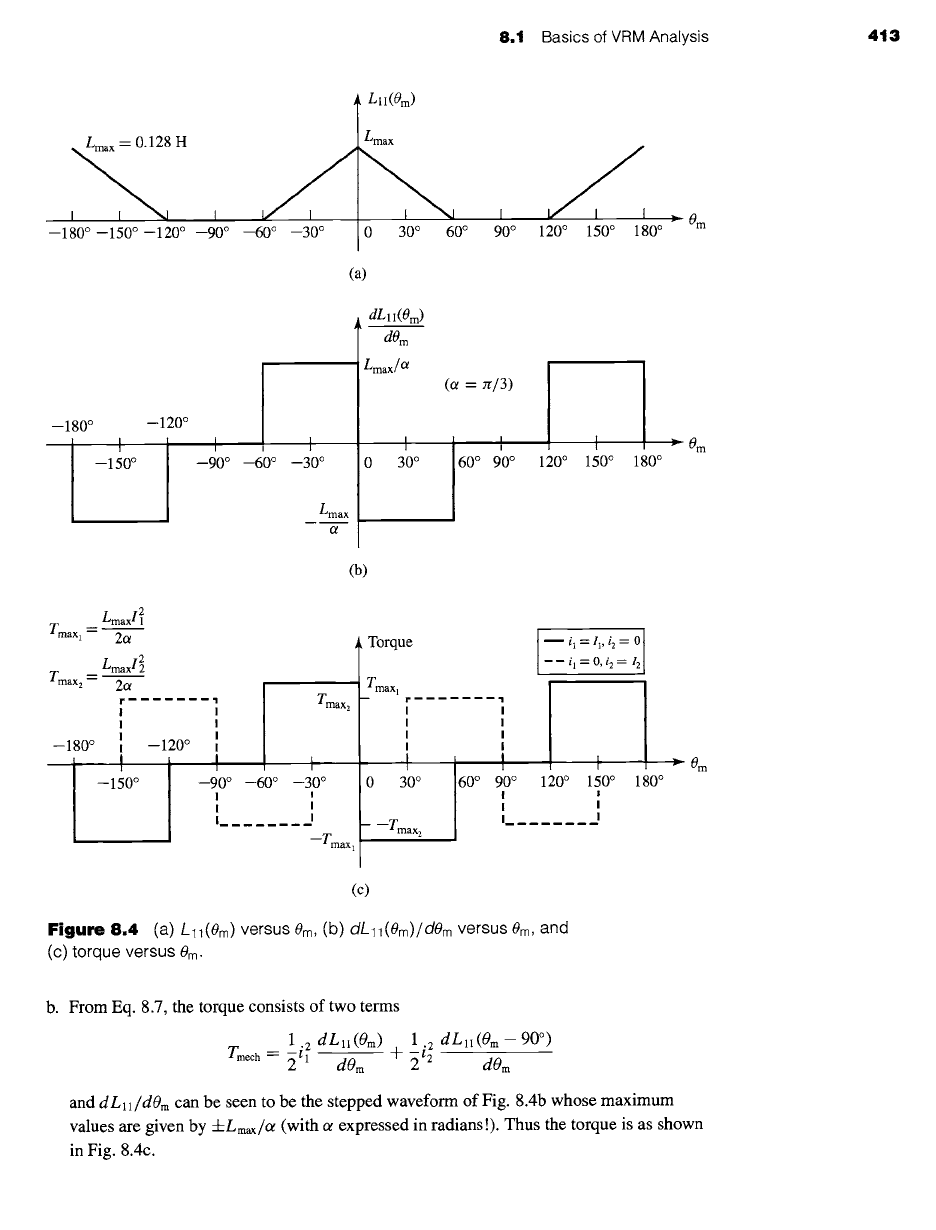
8.1 Basics of VRM Analysis 413
Lma x --
0.128 H
--180 °-150 °-120 ° --90 ° --60 ° --30 °
Lll(em)
Zmax
0 30 ° 60 °
/
I I~ I I
>
Om
90 ° 120 ° 150 ° 180 °
(a)
-- 180 °
I
--150 °
--120 °
I I
--90 ° --60 ° --30 °
Lmax
dLll(O m)
dO m
Lmax/Ot
I
0 30 °
(a = ]r/3)
i
i
60 ° 90 °
120 ° 150 °
180 °
(b)
Lmax I2
Tmax~ = 2or
Lmax I2
Tmax2 -- 2o~
[
i
- 180 ° || - 120 °
-i
--150 °
Tmax 2
i
,,
i L
i
--90 ° --60 ° --30 °
I I
I I
I_ I
ITm rque
axl r
L ..... I
I
0 30 °
--rmax,
--rmax~
(c)
60 ° 120 °
I
I
I
!
i
90 °
I
I
I_
i 1 = 11, i 2 = 0
• ---i1=0, i2-'I 2
~_ ==
150 ° 180 °
!
i
i
Figure 8.4 (a)
L11(0m) versus 0m, (b)
dL11(Orn)/dOm
versus 0m, and
(c) torque versus 0rn.
>0m
>0m
b. From Eq. 8.7, the torque consists of two terms
1 2 dLll
(0m) 1.2
dLll
(0m -- 90 °)
Tmech = ~ il dora + 2 t2
dOm
and
dLll/dOm
can be seen to be the stepped waveform of Fig. 8.4b whose maximum
values are given by -'Ftmax/O/(with ot expressed in radians!). Thus the torque is as shown
in Fig. 8.4c.

414 CHAPTER
8 Variable-Reluctance Machines and Stepping Motors
c. The peak torque due to each of the windings is given by
= (\~2__)i2= (0"128) 52=l'53N'm2(n'/3)
Tmax
(i) From the plot in Fig. 8.4c, at 0m = 0 °, the torque contribution from phase 2 is clearly
zero. Although the phase-1 contribution appears to be indeterminate, in an actual
machine the torque change from Tmax, to -Tmax, at 0m = 0 ° would have a finite slope
and the torque would be zero at 0 = 0 °. Thus the net torque from phases 1 and 2 at
this position is zero.
Notice that the torque at 0m -- 0 is zero independent of the current levels in phases 1
and 2. This is a problem with the 4/2 configuration of Fig. 8.3 since the rotor can get
"stuck" at this position (as well as at 0m = +90 °, +180°), and there is no way that
electrical torque can be produced to move it.
(ii)
At 0m = 45 ° both phases are providing torque. That of phase 1 is negative while that
of phase 2 is positive. Because the phase currents are equal, the torques are thus
equal and opposite and the net torque is zero. However, unlike the case of 0m -- 0 °,
the torque at this point can be made either positive or negative simply by appropriate
selection of the phase currents.
(iii)
At 0m = 75 ° phase 1 produces no torque while phase 2 produces a positive torque of
magnitude Tmax2. Thus the net torque at this position is positive and of magnitude
1.53 N. m. Notice that there is no combination of phase currents that will produce a
negative torque at this position since the phase-1 torque is always zero while that of
phase 2 can be only positive (or zero).
)ractice Problem 8.
Repeat the calculation of Example 8.1, part (c), for the case in which a = fl = 70 °.
Solution
(i) T=0N.m
(ii) T=0N.m
(iii) T=1.59N.m
Example 8.1 illustrates a number of important considerations for the design of
VRMs. Clearly these machines must be designed to avoid the occurrence of rotor
positions for which none of the phases can produce torque. This is of concern in the
design of 4/2 machines which will always have such positions if they are constructed
with uniform, symmetric air gaps.
It is also clear that to operate VRMs with specified torque characteristics, the
phase currents must be applied in a fashion consistent with the rotor position. For
example, positive torque production from each phase winding in Example 8.1 can
be seen from Fig. 8.4c to occur only for specific values of 0m. Thus operation of
VRMs must include some sort of rotor-position sensing as well as a controller which

8.2 Practical VRM Configurations 415
determines both the sequence and the waveform of the phase currents to achieve
the desired operation. This is typically implemented by using electronic switching
devices (transistors, thyristors, gate-turn-off devices, etc.) under the supervision of a
microprocessor-based controller.
Although a 4/2 VRM such as in Example 8.1 can be made to work, as a practical
matter it is not particularly useful because of undesirable characteristics such as its
zero-torque positions and the fact that there are angular locations at which it is not
possible to achieve a positive torque. For example, because of these limitations, this
machine cannot be made to generate a constant torque independent of rotor angle; cer-
tainly no combination of phase currents can result in torque at the zero-torque positions
or positive torque in the range of angular locations where only negative torque can be
produced. As discussed in Section 8.2, these difficulties can be eliminated by 4/2 de-
signs with asymmetric geometries, and so practical 4/2 machines can be constructed.
As has been seen in this section, the analysis of VRMs is conceptually straightfor-
ward. In the case of linear machine iron (no magnetic saturation), finding the torque
is simply a matter of finding the stator-phase inductances (self and mutual) as a func-
tion of rotor position, expressing the coenergy in terms of these inductances, and then
calculating the derivative of the coenergy with respect to angular position (holding
the phase currents constant when taking the derivative). Similarly, as discussed in
Section 3.8, the electric terminal voltage for each of the phases can be found from the
sum of the time derivative of the phase flux linkage and the i R drop across the phase
resistance.
In the case of nonlinear machine iron (where saturation effects are important)
as is discussed in Section 8.4, the coenergy can be found by appropriate integration
of the phase flux linkages, and the torque can again be found from the derivative
of the coenergy with respect to the angular position of the rotor. In either case,
there are no rotor windings and typically no other rotor currents in a well-designed
variable-reluctance motor; hence, unlike other ac machine types (synchronous and
induction), there are no electrical dynamics associated with the machine rotor. This
greatly simplifies their analysis.
Although VRMs are simple in concept and construction, their operation is some-
what complicated and requires sophisticated control and motor-drive electronics to
achieve useful operating characteristics. These issues and others are discussed in
Sections 8.2 to 8.5.
8.2 PRACTICAL VRM CONFIGURATIONS
Practical VRM drive systems (the motor and its inverter) are designed to meet oper-
ating criteria such as
n Low cost.
m Constant torque independent of rotor angular position.
m A desired operating speed range.
m High efficiency.
m A large torque-to-mass ratio.
